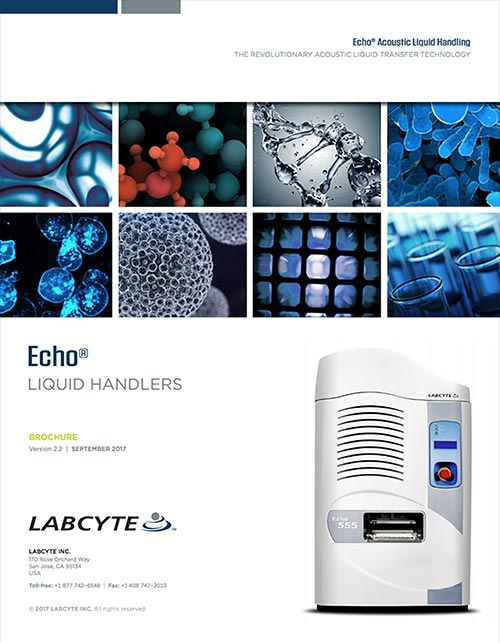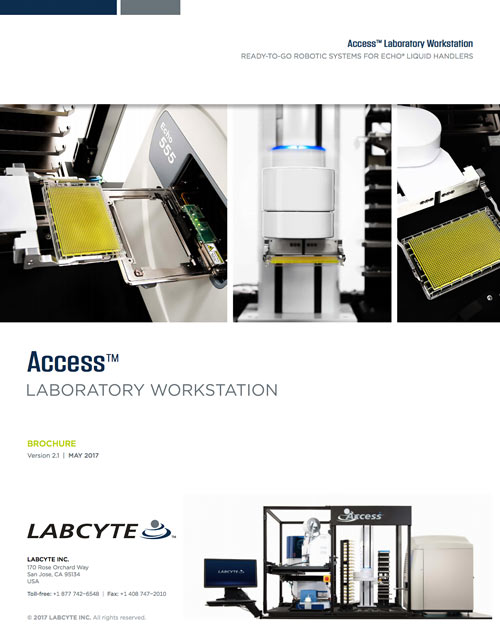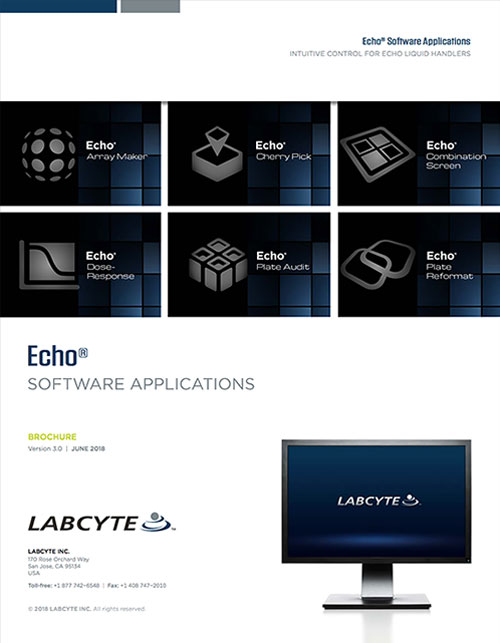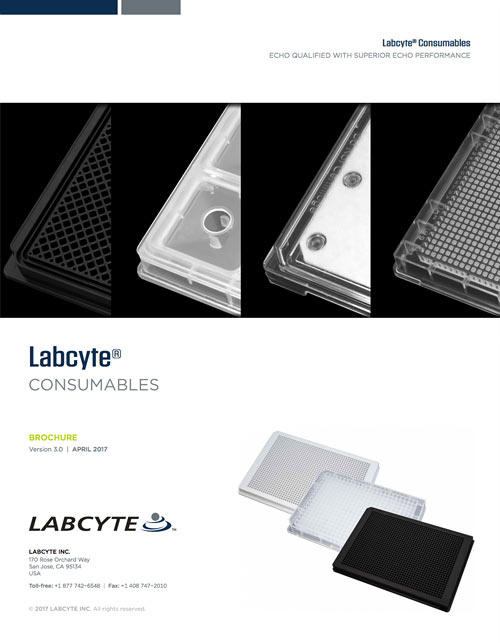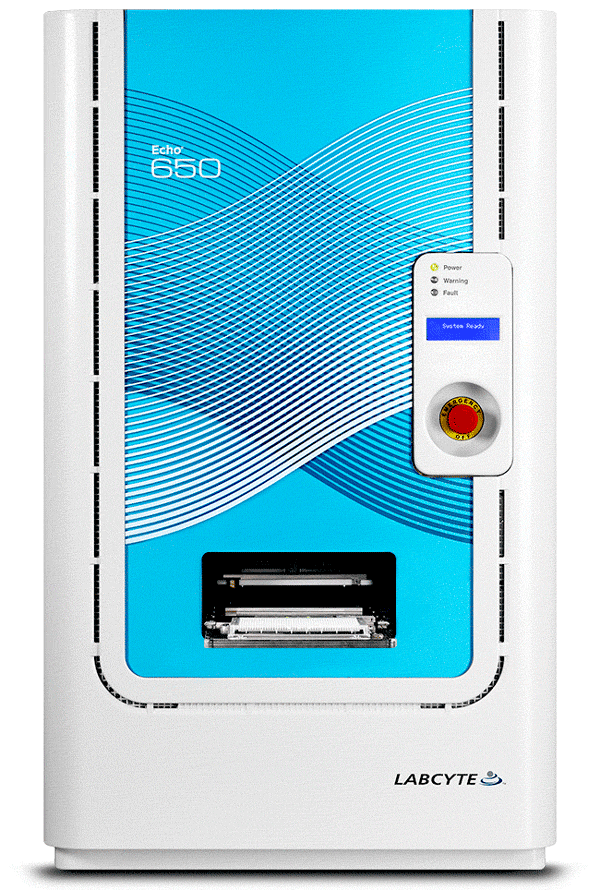
NEW
Echo 650 LIQUID HANDLER
Next generation medium-throughput system
- Enables assay miniaturization in a broad range of applications
- Transfer from 384-well and 1536-well microplates
- Accurate, precise, contact-free acoustic transfer in volumes as low as 2.5 nL
Another Step Forward for Acoustic Liquid Handling
The Echo 650 Liquid Handler is ideal for medium-throughput applications. It enables the transfer of as little as 2.5 nL from 384-well and 1536-well microplates. As your research needs change, upgrade packages are available that enable the addition of Echo Qualified sample tube capabilities.
Key Benefits
- Measure DMSO hydration levels to gain insights into sample integrity and improve transfer quality
- Elimination of compound loss, cross-contamination, carryover, or leachates through non-contact transfer
- Accurate and precise transfer of nanoliter-scale quantities, enabling assay miniaturization, further reducing costs
- Better results through direct dilution of compounds, an improvement over serial dilution methods
- Flexibility to transfer any volume of liquid from any source well to any destination well
Echo Acoustic Liquid Handling|by Labcyte Inc.
Watch the Echo acoustic droplet ejection (ADE) technology in action. Sound waves eject precisely-sized droplets from the source plate onto the destination plate suspended above.
Impacting Therapeutic Discovery
Tipless, non-contact, acoustic fluid transfers eliminate the potential for samples or compounds to adhere to plastic tips. This helps to improve data quality, increasing the potential to find new therapeutics.
In a screen of 975 compounds, Bristol-Myers Squibb found 108 more hits when using the Echo Liquid Handler1.
1 Spicer T., Fitzgerald Y., Burford N., Matson S., Chatterjee M., Gilchrist M.,Myslik J., O'Connell J.
Pharmacological evaluation of different compound dilution and transfer paradigms on an enzyme assay in low volume 384-well format. Poster presented at Drug Discovery Technology, August 2005, Boston, MA.
32% More Active Compounds Found
Potent by
Echo transfer
108 | 32%
Potent by
both methods
230 | 68%
Save Compounds and Money by Miniaturizing Assays
Set up 384-well cell-based and biochemical assays or transition into 1536-well formats with no loss of performance. The nanoliter volume transfers of the Echo 655T systems enable direct dilution of concentrated compounds from sample plates – eliminating workflow steps and keeping the final concentration of DMSO low in the final assay. Data accuracy is further improved through the elimination of compound loss on tips.
Decrease Cost and Maintain Data Quality

The high-performance fluid transfer of Echo 650 Liquid Handler delivers comparable transfer efficiency, knock-down, and cell morphology reactions to traditional liquid handlers with less use of sample and reagent.
FIGURE 1: Fluorescence image reveals KYSE cells successfully transfected with siGLO(GE Healthcare) (pink), transferred using the Echo Liquid Handler1
Sample
- ■ Echo Dispensed
- ■ Manually Dispensed
FIGURE 2: Inclusion intensities of esophageal cancer cells transfected using the Echo Liquid Handler vs. manual transfer. Error bars indicate standard deviations.1
Transition Into High-Throughput Formats
High assay performance at miniaturized volumes enables researchers to move quantitative assays into higher density formats. Assays such as time-dependent inhibition perform comparably to traditional volumes with less reagent, compound, and the elimination of workflow steps.
- 1
- 2
- 3
- 4
- 5
- - NADPH
- + NADPH
FIGURE 3: Time-dependent CYP3A4 inhibition profiling with two inhibitors.2
| Description | EC50 (nM) |
|---|---|
| - NADPH | 19.14 |
| + NADPH | 18.26 |
| δ IC50 | 1 |
- 1
- 2
- 3
- 4
- 5
- - NADPH
- + NADPH
FIGURE 4: Time-dependent CYP1A2 inhibition profiling with two inhibitors2
| Description | EC50 (nM) |
|---|---|
| - NADPH | 11224 |
| + NADPH | 258.6 |
| δ IC50 | 43 |
Echo 650 Specifications
| Description | Specifications |
|---|---|
| Drop volume | 2.5 nL |
| Volume transfer range | 2.5 nL – 5 µL (dependent on fluid type, assay, and source plate used) |
| Reagents supported | DMSO, PCR and qPCR reagents, synthetic biology reagents, NGS reagents, primers and probes, cell culture media, proteins, nucleic acids, up to 50% glycerol, serum, plasma, antibodies, enzymes, and protein crystallography reagents |
| Transfer accuracy | <10% deviation from target volume |
| Transfer precision | <8% CV (except protein crystallography fluid class) |
| Source labware compatibility | All Echo Qualified 384- and 1536-well Microplates |
| Destination labware compatibility | All Echo Qualified Microplates and most ANSI-compliant/SBS-standard microplates in 96-, 384-, 1536-, and 3456-well formats 8 to 16 mm well height |
| Barcode reader options | Short-side and/or long-side |
| Dimensions | 53.9 cm width x 68.3 cm depth x 92.5 cm height (21.2 x 26.9 x 36.4 inches) |
| Weight | 130 kg (286 lbs) |
| Working envelope | Additional 25.4 cm (10 inches) on top, 2.5 cm (1 inch) on sides, 7.6 cm (3 inches) at front, 30.5 cm (12 inches) at back |
| Electrical | AC 120V, 50/60 Hz, 10 A or AC 230V, 50/60Hz, 5 A |
| Operating temperature | 21°C ± 5°C (70°F ± 9°F) |
| Vacuum | House supply minimum 200 Torr (266 mbar, 22 inches Hg Vac) OR Standalone vacuum with surge tank, minimum pump speed 2.0 m3/hr, minimum pressure 100 Torr (133 mbar, 26 inches Hg Vac) |
| Fluid class calibration | No calibration needed |
